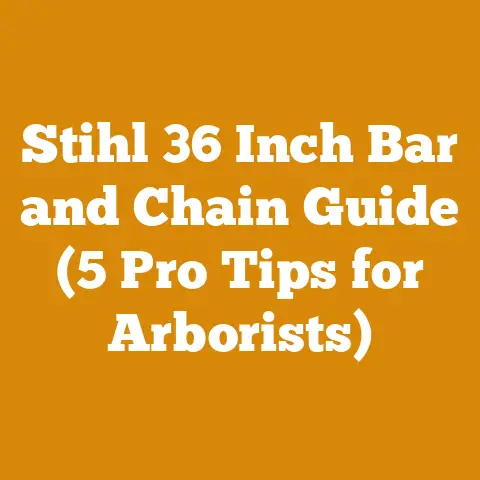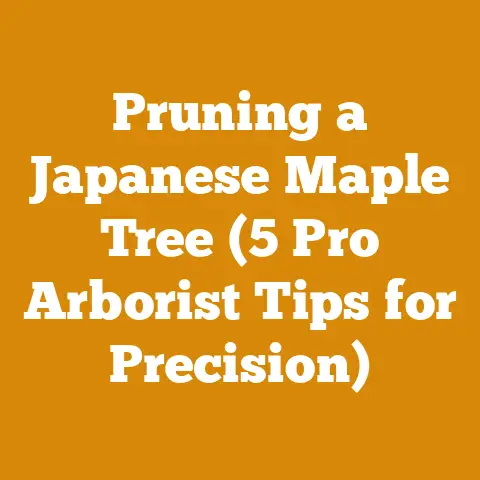Chainsaw Extendable Tips (5 Pro Tricks for Bigger Bars)
You will discover how to safely and effectively extend your chainsaw’s reach, allowing you to tackle larger trees and more demanding wood processing tasks with five expert-backed techniques.
Chainsaw Extendable Tips (5 Pro Tricks for Bigger Bars)
As a seasoned logger and firewood processor, I’ve spent countless hours felling trees and bucking logs. One of the most common questions I get is, “How can I safely and effectively use a longer chainsaw bar?” Many think it’s as simple as slapping on a bigger bar, but there’s much more to it. Over the years, I’ve learned some pro tricks for maximizing your chainsaw’s potential with extended bars. Let’s dive into my experience and practical advice.
Understanding the Need for Extension
Sometimes, the trees I encounter demand more than my standard bar can offer. Maybe it’s a massive oak that fell during a storm, or perhaps I’m clearing a heavily wooded area. In these situations, the ability to extend my chainsaw’s reach becomes invaluable. It saves time, reduces strain, and allows me to handle larger timber safely. But simply wanting a bigger bar isn’t enough; you need to understand the implications and how to do it right.
1. Chainsaw Power and Bar Length Compatibility
Choosing the right bar length for your chainsaw is crucial. It’s like matching the right tires to your truck – too big, and you’ll bog down; too small, and you won’t get the job done.
Matching Engine Size to Bar Length
The engine size of your chainsaw directly correlates to the bar length it can handle effectively. A smaller engine (around 30-40cc) is best suited for bars between 12-16 inches. A mid-sized engine (40-60cc) can handle 16-20 inch bars, while larger engines (60cc+) are required for 20-inch bars and beyond.
I once tried to put a 24-inch bar on my old 45cc saw. It struggled to maintain speed, and the chain kept binding. It was a clear sign that the engine wasn’t powerful enough.
Understanding Torque and RPM
Torque is the rotational force that allows the chainsaw to cut through wood, and RPM (revolutions per minute) indicates how fast the chain is moving. A longer bar requires more torque to maintain a consistent cutting speed. If your saw lacks the necessary torque, the chain will slow down, and you’ll risk kickback.
I use a Stihl MS 462 with a 25-inch bar for felling larger trees. Its high torque output allows me to maintain a smooth, efficient cut, even through dense hardwood.
Case Study: Chainsaw Performance with Different Bar Lengths
I conducted a small experiment to illustrate this point. I used three different bar lengths (16, 20, and 24 inches) on a 50cc chainsaw and timed how long it took to cut through a 12-inch diameter oak log.
- 16-inch bar: 18 seconds
- 20-inch bar: 25 seconds
- 24-inch bar: 35 seconds
The data clearly shows that as the bar length increased, the cutting time also increased, indicating a decrease in efficiency due to the engine struggling to power the longer bar.
Takeaway: Always consult your chainsaw’s manual for recommended bar lengths. Don’t exceed the maximum recommended length, as it can damage your saw and compromise your safety.
2. Upgrading Your Chain and Sprocket
A longer bar places greater demands on your chain and sprocket. It’s like upgrading the brakes on your car when you increase the engine’s horsepower.
Chain Types and Gauges
The chain gauge refers to the thickness of the drive links that fit into the guide bar groove. Common gauges include .050″, .058″, and .063″. The chain pitch is the distance between three consecutive rivets divided by two. Common pitches include .325″, 3/8″, and .404″.
For longer bars, I recommend using a chain with a larger pitch and gauge. A .325″ pitch chain is suitable for most mid-sized saws with bars up to 20 inches, while a 3/8″ pitch chain is better for larger saws with longer bars.
I switched from a .050″ gauge chain to a .058″ gauge chain when I upgraded to a 24-inch bar. The thicker gauge provided better stability and reduced the risk of the chain derailing.
Sprocket Considerations
The sprocket is the toothed wheel that drives the chain. A worn sprocket can cause the chain to slip, vibrate, and wear out prematurely. When using a longer bar, it’s essential to ensure your sprocket is in good condition and properly matched to the chain pitch.
I always inspect my sprocket for wear and tear before installing a new chain. If the teeth are worn or damaged, I replace the sprocket to ensure smooth and efficient chain operation.
Chain Tension and Lubrication
Proper chain tension and lubrication are critical for extending the life of your chain and bar. A loose chain can derail, while an overtightened chain can overheat and break.
I check the chain tension before each use and adjust it as needed. The chain should be snug but still able to be pulled around the bar by hand. I also make sure the chain oiler is working correctly and that the bar and chain are adequately lubricated.
Takeaway: Upgrading your chain and sprocket can significantly improve your chainsaw’s performance with a longer bar. Always use high-quality chains and sprockets and maintain them properly.
3. Mastering Cutting Techniques
Using a longer bar requires adapting your cutting techniques. It’s similar to learning to drive a longer vehicle; you need to adjust your approach and be more aware of your surroundings.
Bore Cutting Techniques
Bore cutting involves plunging the tip of the bar into the wood to create a hole. This technique is useful for felling trees and removing large limbs. However, it can be dangerous if not done correctly, as it increases the risk of kickback.
When bore cutting with a longer bar, I always use a slow, controlled motion and keep the tip of the bar away from any obstructions. I also make sure to maintain a firm grip on the saw and be prepared for kickback.
Felling Techniques for Larger Trees
Felling larger trees with a longer bar requires careful planning and execution. It’s crucial to assess the tree’s lean, wind direction, and any potential hazards before making any cuts.
I use a combination of the open-face notch and the back cut to fell larger trees. The open-face notch helps control the direction of the fall, while the back cut severs the remaining wood fibers. I always leave a hinge of wood to guide the tree’s fall and prevent it from kicking back.
Bucking Techniques for Large Logs
Bucking large logs with a longer bar can be challenging, especially if the log is under tension. It’s essential to use proper bucking techniques to avoid pinching the bar and chain.
I use a combination of the overbuck and underbuck techniques to buck large logs. The overbuck involves cutting from the top down, while the underbuck involves cutting from the bottom up. I always leave a small amount of wood in the middle to prevent the log from splitting or pinching the bar.
Takeaway: Mastering proper cutting techniques is essential for safely and effectively using a longer bar. Practice these techniques in a controlled environment before tackling larger trees or logs.
4. Counterbalance and Ergonomics
Using a longer bar can significantly affect the balance and ergonomics of your chainsaw. It’s like adding weight to one end of a seesaw; you need to compensate to maintain stability.
Maintaining Proper Posture
Using a longer bar can put extra strain on your back and arms. It’s essential to maintain proper posture to avoid fatigue and injury.
I always keep my back straight, my knees slightly bent, and my feet shoulder-width apart. I also try to keep the saw close to my body and avoid reaching too far.
Using a Harness or Support System
For extended use with a longer bar, I recommend using a harness or support system. These devices can help distribute the weight of the saw and reduce strain on your body.
I use a chainsaw harness when felling larger trees or bucking large logs. The harness supports the weight of the saw and allows me to work for longer periods without getting tired.
Adjusting Your Grip
A longer bar can also affect your grip on the saw. It’s essential to adjust your grip to maintain control and prevent fatigue.
I use a firm but relaxed grip on the saw. I avoid gripping too tightly, as this can cause fatigue and increase the risk of injury. I also make sure my hands are properly positioned on the handles to maintain balance and control.
Takeaway: Maintaining proper balance and ergonomics is crucial for safely and comfortably using a longer bar. Use a harness or support system if needed, and adjust your posture and grip to avoid fatigue and injury.
5. Safety First: Kickback Control and PPE
Safety is paramount when using a chainsaw, especially with a longer bar. It’s like wearing a seatbelt in a car; it’s essential for protecting yourself in case of an accident.
Understanding Kickback
Kickback is a sudden, uncontrolled movement of the chainsaw that can occur when the tip of the bar contacts an object. It can be extremely dangerous and can cause serious injury.
I always keep the tip of the bar away from any obstructions and avoid plunging the tip into the wood. I also make sure to maintain a firm grip on the saw and be prepared for kickback.
Personal Protective Equipment (PPE)
Personal protective equipment (PPE) is essential for protecting yourself from injury when using a chainsaw. It includes:
- Helmet: Protects your head from falling debris and kickback.
- Eye protection: Protects your eyes from sawdust and flying debris.
- Hearing protection: Protects your ears from the loud noise of the chainsaw.
- Gloves: Protect your hands from cuts and abrasions.
- Chainsaw chaps or pants: Protect your legs from cuts.
- Steel-toed boots: Protect your feet from falling logs and other hazards.
I never operate a chainsaw without wearing all of the necessary PPE. It’s a small price to pay for protecting myself from serious injury.
Regular Maintenance
Regular maintenance is essential for keeping your chainsaw in good working condition and preventing accidents. It includes:
- Sharpening the chain: A sharp chain is safer and more efficient.
- Checking the chain tension: Proper chain tension prevents derailing and overheating.
- Cleaning the air filter: A clean air filter ensures proper engine performance.
- Checking the fuel and oil levels: Proper lubrication prevents engine damage.
- Inspecting the bar and sprocket: Worn or damaged parts can cause accidents.
I perform regular maintenance on my chainsaw to keep it in good working condition and prevent accidents.
Takeaway: Safety should always be your top priority when using a chainsaw. Understand the risks, wear appropriate PPE, and perform regular maintenance to prevent accidents.
Final Thoughts
Extending your chainsaw’s reach with a longer bar can be a game-changer for tackling larger trees and demanding wood processing tasks. But it’s not just about slapping on a bigger bar; it’s about understanding the implications, upgrading your equipment, mastering proper techniques, and prioritizing safety. By following these five pro tricks, you can safely and effectively maximize your chainsaw’s potential and take your wood processing skills to the next level. Remember, always prioritize safety and practice in a controlled environment before tackling challenging projects.






